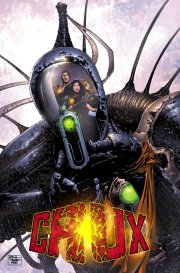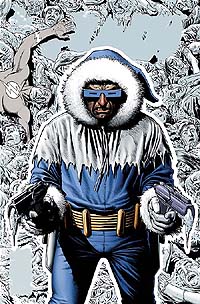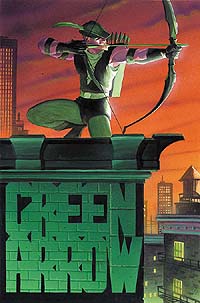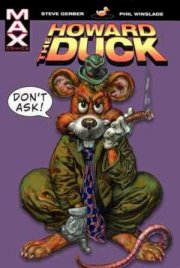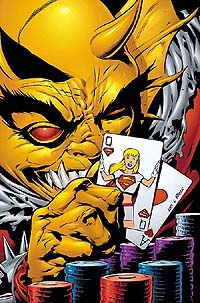|
Each week we take a critical look at some of the best books on the stands, courtesy of Big Guy's Comics (the unofficial comic book store of FanboyPlanet.com). If you publish a book that you want us to be covering, contact us. Or contact Derek. He doesn't have enough to do.
Hey Kids! Comics!
Crux #10
writer: Mark Waid, artists: Steve Epting and Rick Magyar
reviewed by Charlie WentlingThis issue wraps up the story that has been running for the past two months. For the first time Crux has a credible villain and a real sense of danger for the Atlanteans. Capricia and the others are trying to repair the malfunctioning tachyon supercollider that is causing the humans to shift in and out of the timestream. Verityn and Danik were sent into the distant past last month, and they are still gone.
The new Negation Warrior is hunting down the Atlanteans one by one. The twins Galvan and Gammid play an important role, and their true feelings for each other are revealed. The resolution is slightly different than I was expecting, and it looks like one of the core characters is leaving the book permanently.
Rating:

The Flash #182
Absolute Zero
writer: Geoff Johns, artists: Scott Kolins and Dan PanosianThough Brian Bolland delivers a dynamic cover, it seems too glib for the complex story within. Johns has not so much re-villainized Len Snart, aka Captain Cold, as rethought him. It's a new era with new Rogues, and Captain Cold does not quite have a place.
Cold acknowledges as much, as Keystone's drug lord The Candyman mentions that he has been promised immunity from the Rogues. But for Captain Cold destroying Wally is beside the point, leaving him with no use for super-villain alliances. What he wants this issue is revenge. And after all, revenge is a dish best served cold.
Some of his origin feels a bit overdone, but Johns has done a good job of explaining how an abused kid would become a costumed villain. The writer also takes care of some unfinished business in Cold's continuity, and provides some nasty new uses for Cold's guns. Len Snart may not be a scientific genius, operating with borrowed technology, but he has learned to use it well.
In the end, we do not know how to feel about Cold's place in Keystone, but that's only right. He doesn't know, either. It may be a bit messy, but it's real. And it also just might get Johns and Kolin that Captain Cold mini-series.
Rating:

Green Arrow #11
Ultimate Speedy
writer: Kevin Smith, artists: Phil Hester and Ande ParksDespite the title's implication, it would be too easy to make Mia into Green Arrow's new sidekick. She dreams of it, of course, as well as of filling another void in his life. But Ollie has left enough wasted youth in his wake: Arsenal, Connor, and both Arrowettes (even if he doesn't know it). There are too many old wounds to heal for him to start causing new ones.
Smith only has a couple of issues left on his run to explore this, but it seems that that's where he's headed. Connor has spent an unchronicled week getting to know his father, with the implication that he's in this book to stay. Arsenal will probably be ignored, as it also looks like Black Canary will become a fixture, too.
So what to do with Mia? Well, Smith has set up a slightly uncomfortable sexual tension for whoever follows him. On one hand, that makes sense. Oliver Queen always played millionaire playboy far more seriously than Bruce Wayne did. But it's going to get sticky.
Now that the plot has settled and all we have left are slices of life, some cracks are showing. Smith is running into the real danger of becoming a Generation X Neil Simon. Everyone talks with the same glib coarseness. The rhythms of Mia's speak and Oliver's should be completely different, but they're not. For a guy who has been dead for a couple of years, Green Arrow sure has picked up the lingo.
It only really jars, though, with Connor. This was a quiet, self-effacing guy whose charm lay in not so much naivete as obliviousness to anything beyond his heroism. Reading Smith's version, you'd never know he was raised in a monastery and liked it. The Connor Hawke here has suddenly let go of his own characterization. For a guy who has spent most of his career pining to get to know his father, he sure seems mouthy. Someboy fix this guy, quick.
Rating:

Howard The Duck #1
Making The Band
writer: Steve Gerber, artist: Phil WinsladeIf ever there was a case for letting creators own their characters, Howard The Duck is it. Forget about the movie and the easy deserved potshots at its expense; Lucasfilm had no idea what the character was about. Nor for the most part has Howard's ostensible owner, Marvel. Only Steve Gerber seems to be able to tap into why people liked the duck in the first place, and thankfully, he has him back for now.
Unfortunately, Gerber has also written a first issue for those who know and love Howard from days past, which makes it not the most accessible of books. Howard's origin is beside the point, but this issue ties into continuity from the first series, way back in the seventies. Though it makes sense to use the "mystery" villain for this particular plot, his presence and his baggage will leave new readers scratching their heads.
What will keep new readers' attention is the satire, though Gerber may have picked an easy target. Howard's human companion Beverly Switzer lands a too cushy job administering somewhat disturbing marketing research (the kind that could only happen in a MAX book) over boy bands. It's a little obvious, but the richness of Gerber's writing distracts from that.
Phil Winslade proves to be the perfect artist for this book, too, calling to mind the detail and style of Frank Brunner, who designed Howard originally. Not that it necessarily matters, since Disney mandated Howard change in appearance, which explains why Howard appears as a rat on the cover. Too bad that's supposed to be the cliffhanger for the first issue; it is one of Gerber's weaknesses that he does let his cleverly channeled ire run away from him at times.
Still, he's one of the few writers who actually does satire correctly, and the comics industry needs his voice. Welcome back, Steve. Welcome back, Howard.
Rating:

JSA #32
Stealing Thunder
writers: David Goyer and Geoff Johns, artist: Peter SnejbjergWizard just named this the Best Comic of 2001, an accolade DC slapped across the top of the cover. They may be right, because JSA always manages to run at an even keel, always serves as a solid, fun read, and never runs out of surprises.
Regular writer Geoff Johns welcomes back the man who started the book, David Goyer, returning from adventures in Hollywood. Appropriately, they're starting an epic storyline, the seeds of which Johns planted so quietly that you won't believe you forgot about them.
Most of the story acknowledges that changes are happening for the team, and, like last issue, would serve as a good jumping on point for new readers. Everybody gets a few panels to shine, touching base with the various subplots. If weighed a little heavily toward newcomer Power Girl (who Peter Snejbjerg remembers is also a big girl), that's okay, because Johns and Goyer obviously have big plans for her.
Since this book managed to make us not care about Hawkman's baggage, I can hardly wait to see how they clear up Karen Starr's post-Crisis crap.
The cover, however, points out that this should be about Johnny Thunder, a character cleverly revived a couple of issues ago, now approaching the team for the first time. After reading the issue a second time, there does seem to be a slight characterization "cheat" to misdirect us, only slightly annoying.
Making up for it is Snejbjerg's art. He brings as much characterization to the book as the writers do, making everybody look cool. Dr. Fate, in particular, looks disturbing (and disturbed), but in a way that makes sense. And he gives the Thunderbolt a fluidity that a lot of artists miss.
Rating:

The Power Company: Bork #1
Vulnerability
writer: Kurt Busiek, artist: Kieron DwyerAhh. Right. This is why I've bought all these books, because Busiek has a way of taking superhero clichés and turning them on their heads. It's a shame that most of these specials have seemed just done in his sleep, because Bork makes a solid read. It's not quite as unique as Jeremiah Power, but it takes a forgotten (and deservedly so until now) villain and recasts him without it feeling forced.
Granted, Bork does not have much in the way of pre-conceived notions. Having appeared in one issue of Brave and the Bold, he didn't make much of an impact (a lot of B&B villains tended to disappear immediately). The story of his change does not feel forced, though.
Busiek balances between the simpler times when Batman and the Barry Allen Flash were casual friends who would team up for the heck of it and today's more complex storytelling. Most effective of all, he just tells the story, instead of sticking in a connection with other heroes as he did in previous issues.
The name may sound stupid (always was), but the character may be worth your time.
Rating:

Robin #98
The Thin Line
writer: Chuck Dixon, artists: Pete Woods and Andrew PepoyOkay. This book has always been a solid performer, a good read if not really a great one. And as such having a cross-over to direct attention to it would be a good thing.
Except that Chuck Dixon really does not take advantage of it. Of all the chapters in Bruce Wayne: Murderer? so far, this one has the least to do with the crossover plot. Oh, we get a couple of bones here and there. Alfred leaves Tim, in a suitcase packing scene completely different from the one in Gotham Knights (that Dixon, why care what the other writers are doing when you write more books than them, anyway?). And Stephanie The Spoiler discovers that the Batcave has been closed off. That's it.
Otherwise, this issue leaves casual readers confused, making oblique references to subplots that clearly have importance, but we don't know why. Dixon sets up a lot of dominoes to really shake this book up, but gives nothing to make us want to come back to see it happen. If anything, Tim Drake comes off as whiny little dork.
Come on, guy, you have one of the best jobs in the world. And why is it that you seem so confident and cool about it in every other book you appear in?
Rating:

Scion #20
writer: Ron Marz, artists: Jim Cheung and Don Hillsman II
reviewed by Charlie Wentling.Ethan and his companions are determined to find a new sanctuary for the lesser races. He has the idea of using the underwater city that he glimpsed back in issue #5. So, with the aid of Ashleigh, he steals an experimental Raven submarine to go in search of it. Meanwhile, the Heron and Raven armies prepare to clash again, and things don't look so good for the Herons.
The relationship between Ethan and Ashleigh is moving forward. This comes as no surprise, but what is surprising is how effective it is. I can't remember ever seeing sexual tension done so well in a comic book before. Some x-factor is present in Scion that makes me care what happens to these characters.
I want to mention the art team again. Their storytelling abilities are wonderful. Whenever I finish an issue of Scion, I wish that they would draw every other comic that I read. I can't think of any higher praise than that.
Rating:

Supergirl #66
The Vegas Idea
writer: Peter David, artists: Diego Barreto and Robin RiggsYou have to admire a writer who can bring back a plotline from the very first issue without making it feel contrived, even after all the ups and downs the status quo has had. It seems those early Buzz-worshippers in Leesburg were told to convene in Las Vegas if anything went wrong. So for some 60 or so issues, they've been waiting for Buzz to meet them and bring them their original sacrifice: Linda Danvers.
The trouble is, it seems that Buzz completely forgot about that order, but brought Linda to Vegas anyway. It actually plays out pretty believably. Things get more dangerous, though, as in Buzz' absence, the gang decided that they'd raise another demon. Were Buzz still in possession of his demonic faculties, that might be okay. But now any demon they raise will be out of control.
Worse, they pick Etrigan, fresh from Green Arrow.
David rhymes better than Kevin Smith, and so Etrigan reads better here. As the issue opens on The Demon and his human host, Jason Blood, David gets to exercise his humor jones situationally, instead of laying on the bad puns. Be grateful, as he gets it out of his system early.
The biggest weakness this book has, besides the occasional cheap joke, is illustrated in Buzz' current situation. The ex-demon tries to stop the cult, but it's one more flip flop in his behavior, and hard to figure out what his motivations are. It seems he alternates between loving and hating Linda each issue. Maybe we need a little hellfire to straighten things out.
Guest penciller Diego Barreto (is this Eduardo with a new name, or a whole new Barreto?) comes in as a breath of fresh air. Leonard Kirk pencils solidly, but with a sameness to his faces. Barreto has a simpler style, but it provides more variety. Though it's a little embarrassing to say it, it's nice to see Supergirl actually look hot again.
Rating:

Superman: The Man of Steel #122
Superman v Steel
writer: Mark Schultz, artists: Darryl Banks and Kevin ConradFor a guy as bright as John Henry Irons is supposed to be, he sure acts dumb. Despite repeated warnings from Superman about The Entropy Aegis (the most pretentiously named exoskeleton in comics history), Irons continues testing it. But it's okay, because he wears his safety helmet.
He also never seems to learn. Though Natasha, his niece, has continually proven that she will not stay out of his business, he still communicates poorly. Enough time has passed that a natural growth in character could and should happen for both of them.
But enough of that. The villainous Earthquake returns, looking for The Entropy Aegis (never, ever, let a supervillain know exactly who you are and where you live). As we've known it would from the moment it appeared, The Entropy Aegis goes out of control, taking over Steel's mind and forcing him to fight Superman. Wake me when something unexpected happens. (Actually, something does at the end of the issue, but it comes too late to save things.)
Banks and Conrad make a good team, with Conrad's inks giving Banks a very different, but still solid, appearance from his work on Green Lantern. They just need something better to draw than predictable fight scenes.
Rating:

For alternate views and more books, check out Daryl Tay's site, Unique Frequencies.

All comics were reviewed by Derek McCaw unless otherwise noted.













